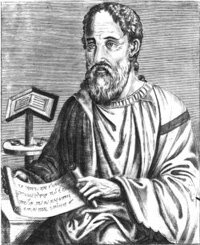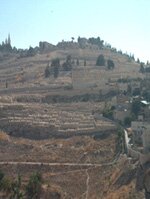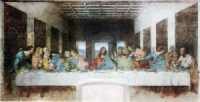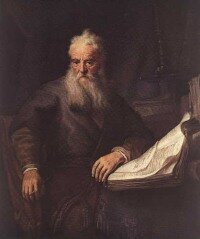
Barnabas was an early
Christian mentioned in the
New Testament. His Hellenic Jewish parents called him Joseph, (although the Byzantine text-type calls him Joses, the Aramaic version of Joseph, (
Aramaic of Jesus) but when he sold all his goods and gave the money to the apostles in
Jerusalem 
they gave him a new name: Barnabas, which means huios parakleseos (Greek: υιος παρακλήσεως) "son of exhortation," or 'man of encouragement.' see
Acts 11:23) and connotes a prophet in the
Early Christian sense of the word (see
Acts 13:1; 15:32). His feast day is June 11. In many English translations of the Bible, including the New International Version (NIV), King James Version (KJV), and New American Standard Bible (NASB), Barnabas is called an apostle. In
Acts 14:14 of these translations, he is listed ahead of Paul, "Barnabas and Paul," instead of "Paul and Barnabas;" both men being described as apostles. Whether Barnabas was an apostle became an important political issue, which was debated in the
Middle Ages.
8-10 There was a man in Lystra who couldn't walk. He sat there,
crippled since the day of his birth. He heard Paul talking, and Paul, looking
him in the eye, saw that he was ripe for God's work, ready to believe. So he
said, loud enough for everyone to hear, "Up on your feet!" The man was up in a
flash—jumped up and walked around as if he'd been walking all his life.
11-13 When the crowd saw what Paul had done, they went wild,
calling out in their Lyconian dialect, "The gods have come down! These men are
gods!" They called Barnabas "Zeus" and Paul "Hermes" (since Paul did most of the
speaking). The priest of the local Zeus shrine got up a parade—bulls and banners
and people lined right up to the gates, ready for the ritual of sacrifice.
14-15 When Barnabas and Paul finally realized what was going on,
they stopped them. Waving their arms, they interrupted the parade, calling out,
"What do you think you're doing! We're not gods! We are men just like you, and
we're here to bring you the Message, to persuade you to abandon these silly
god-superstitions and embrace God himself, the living God. We don't make God; he makes us, and all of this—sky, earth, sea, and everything in them. -Acts 14:10-15 (The Message)
More...
 The term Persian Empire refers to a series of historical empires that ruled over the Iranian plateau. The political entity which was ruled by these kingdoms has been known as Persia throughout history.
The term Persian Empire refers to a series of historical empires that ruled over the Iranian plateau. The political entity which was ruled by these kingdoms has been known as Persia throughout history. 
























